Our first morning in Nagaland started on a mixed note of gloom and gaiety. Last evening’s deluge, which accompanied us all the way from Dibrugarh to Mon, had retreated. Although, it left incessant drizzle in its wake, thereby leading to our pensive mood. Nonetheless, we eventually rejoiced at the thought of meeting some of the last remaining tattooed headhunters of Nagaland.
Post breakfast, we left for Hongphoi, a sleepy village inhabited by a handful of traditional Konyak tattooed headhunters. A bumpy ride later, we arrived at our destination. Our guide took us straight to the home of the Angh or the king/chief of the village. We were asked to hurry as the Angh and his bunch of friends were waiting for us.
Upon reaching the humble hut of the Angh, we were received and warmly welcomed by the petite and jolly Anghya, or the chief queen. Inside the dimly lit, musty hut, a group of elderly headhunters was sitting by the fireplace and merrily chatting over cups of ‘Khalap’ or black tea. Our guide introduced us to Angh Buwang, who offered us tea. Over steaming cups of tea, we started conversing with the old men about their past and present.

Table of Contents
Who are the Konyaks:
The word ‘Konyak’ is probably derived from “Khunyak”, meaning ‘man’. The Konyak is a Tibeto-Burmese ethnic group residing in northeastern India. This tribal group is predominantly found in the Mon district of Nagaland. The tribe is also found in Tirap, Longding, and Changlang districts of Arunachal Pradesh (where they go by the name of ‘Wancho’), Sibsagar district of Assam, and also in some areas of neighboring Myanmar.
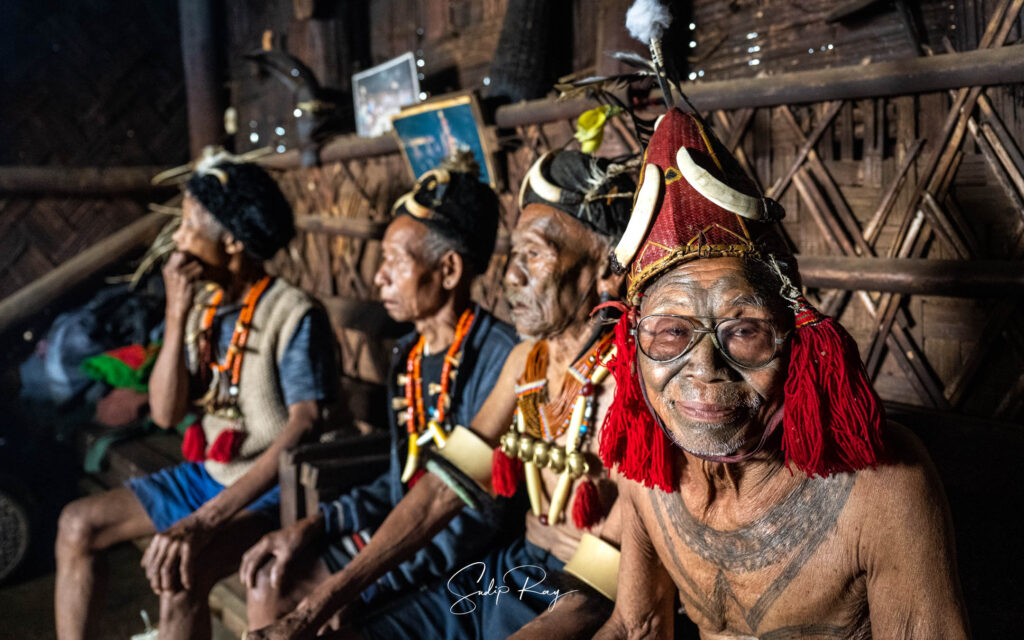
About the Konyak Nagas:
Out of the 17 tribes found in Nagaland, the Konyak is by far the largest. Like the other Naga tribes, they are primarily agrarian and pastoral in nature. Hunting is an essential part of their culture as well. However, what sets them apart from the rest of the Naga tribes is their menacing past of headhunting and the tattooed faces of their warriors.

At present, the tribe has left its warring past back. Originally, followers of primitive animism, the majority of them have embraced Christianity. You will notice churches in every village and town of Mon district. Owing to the missionary influence, the Konyaks have now embraced modernization and Western education. Their primary occupation is still agriculture. They practice terraced or step farming and cultivate paddy, yam, potatoes, and leafy vegetables. They are also known for iron-smelting, brass works, bamboo work, wood carvings, and making excellent machetes or ‘Yanglau’.
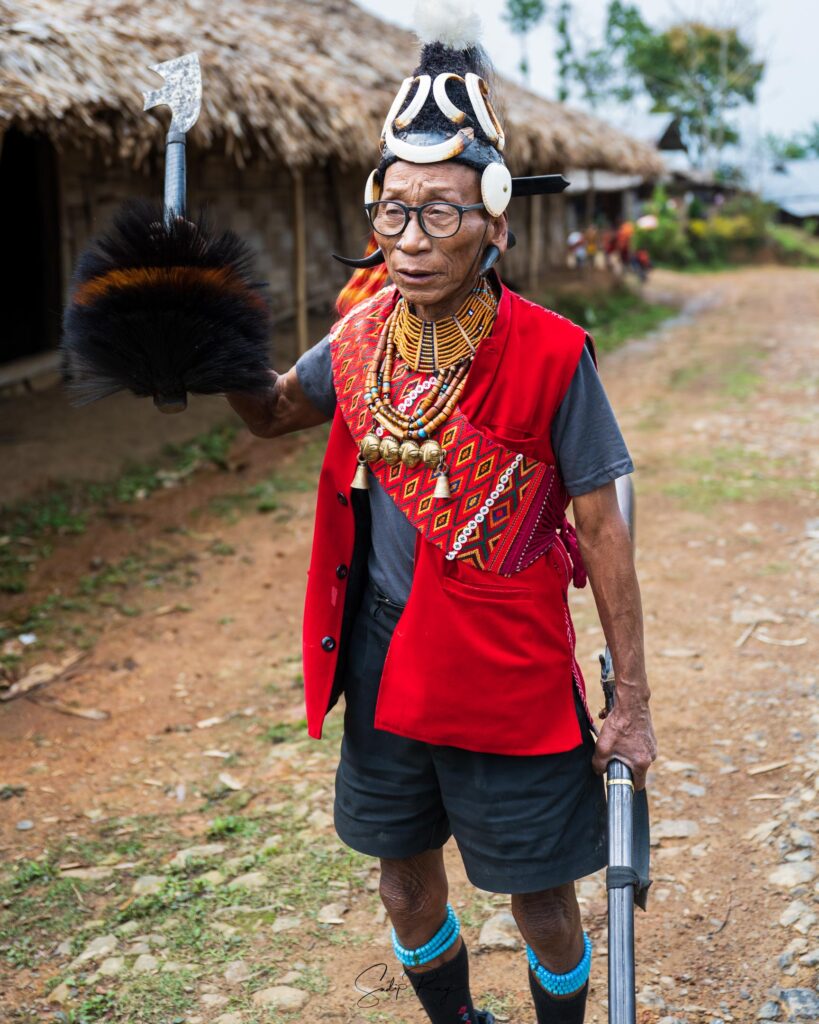
Who are the Konyak Headhunters:
The words ‘Konyak’ and ‘headhunters’ have become somewhat synonymous. Back in the day, this ancient tribe was defined by their headhunting practice.

In the past, scores were settled among the Konyak villages through warfare. They often attacked their neighboring villages, slashed the heads of their opponents, and took those heads as trophies to be decorated at the Morungs or community halls. The heads of the enemies were considered totems and believed to possess mystical power which would bring riches and prosperity to the village. The warriors who hunted the heads of their enemies enjoyed a special status in society and received facial tattoos. The number of enemy heads is used to signify the strength of the warrior as well as the tribe.
However, the Indian Government banned the custom of headhunting. Also, the advent of Christianity in Nagaland reduced warfare and stopped headhunting altogether. The last case of headhunting was reported back in 1969. After the ban, a large number of skulls, which were displayed in the villages, were buried for good.
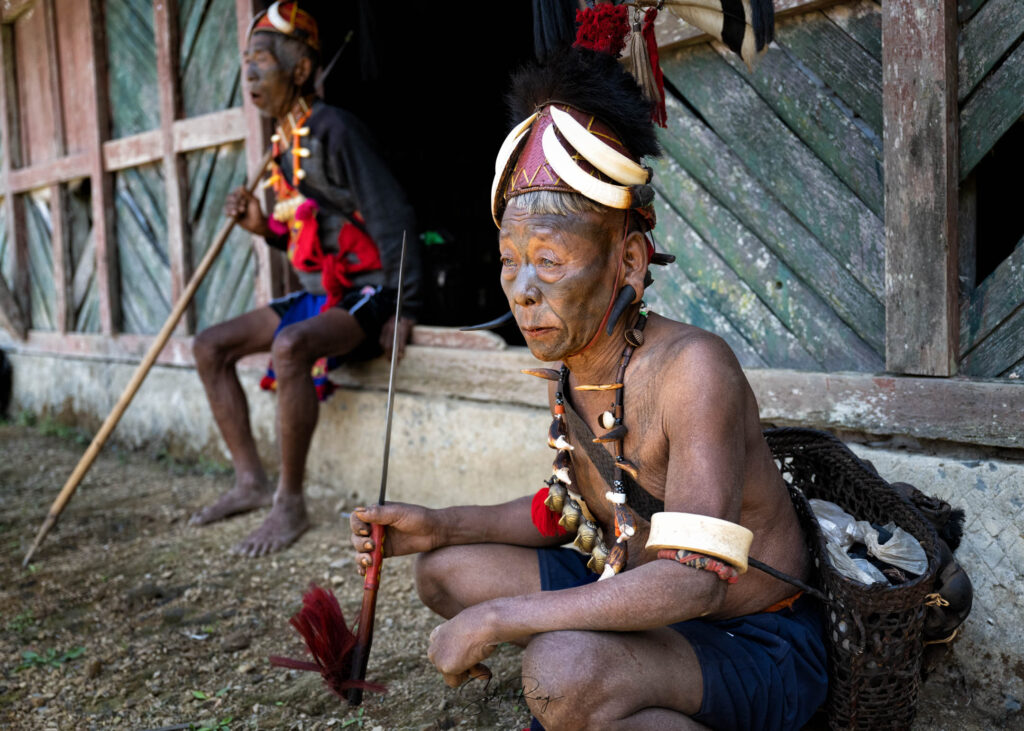
Art of Tattooing among the Konyak Headhunters:
The art of tattooing is an integral piece of the Konyak tradition. The different tattoos worn by a person manifest their social & marital status as also their achievements. Moreover, the designs of tattoos are distinctive for different sections of society. While aristocrats and warriors have exclusive tattoo designs, married and unmarried women are distinguished by their typical tattoos.

Needless to say, the women are more skilled in the art of tattooing. They use special handcrafted tattoo combs, which are made from rattan palm spikes. The tattoo ink is generally made from the resin of a red cedar tree.
After a member of the tribe is inked, a jubilant celebration follows which involves slaughtering a pig or cow. Traditional sticky red rice is served with various meat preparations. The meal is obviously accompanied by a generous dose of homemade rice beer.
However, the most interesting of all is certainly the tattoos of the headhunters. Their tattoos are rather a canvas of their entire lifetime, signifying their heroic splendor. Each tattoo on their bodies tells a tale of their feats as a warrior. After every battle, a Konyak warrior received diamond or lozenge-shaped tattoos for depicting their victories. Curiously, the elaborate and extraordinary facial tattoos were reserved for the most fearsome warriors. Those who returned victorious with enemy heads were gifted with facial tattoos.

The Angh of Konyak tribe:
The tradition of Angh is unique to the Konyak tribe. The word Angh literally translates to ‘king’ or ‘chief’. In this society, there exist two types of Angh – Pongyin Angh, or the Great King or Chief, and Angha, or the Small King.
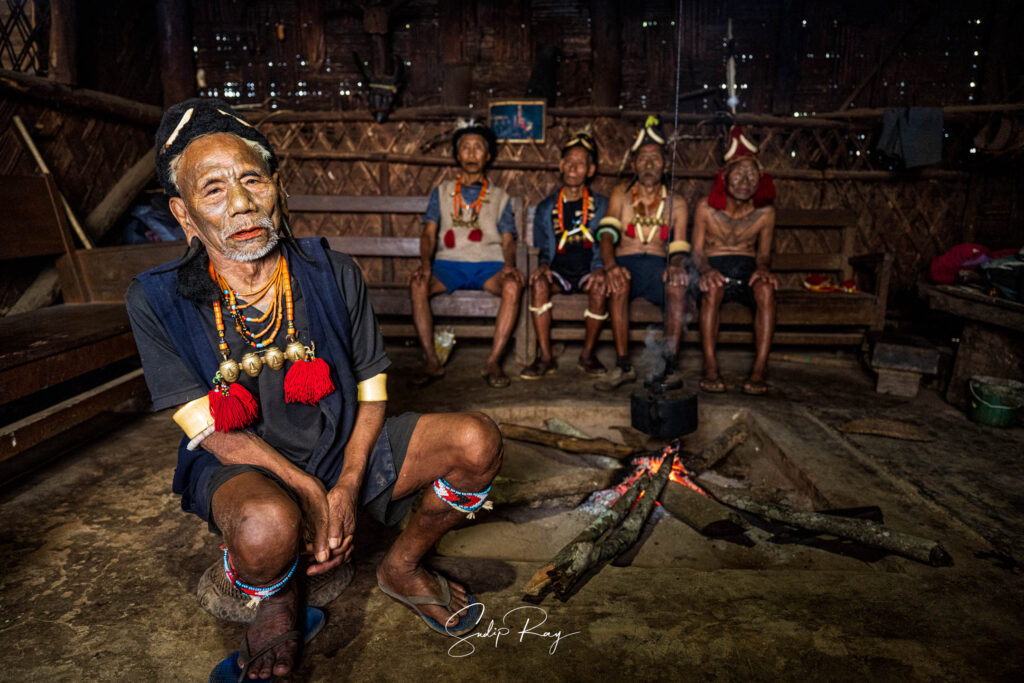
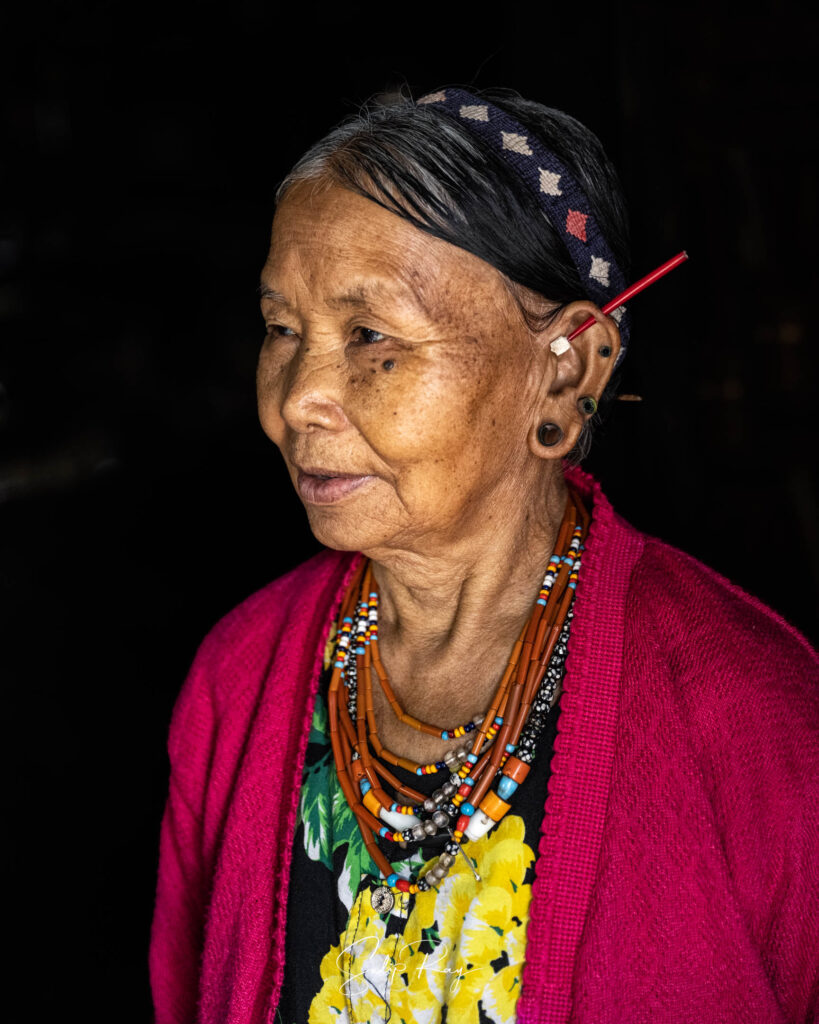
In Mon district, you will find seven Chief Anghs at Mon, Longwa, Shengha Chingnyu, Chui, Shangnyu, Jaboka, and Tangnyu. The Chief Anghs also bear the responsibility of a host of small villages. Such villages are ruled by the Anghas, who are appointed from the family of the Chief Angh. The Anghs conduct the village administration with the help of village councils which are constituted of the village elders.

The Anghs are identified by the rows of blue beads which they wear below their knees. The more layers of blue beads they wear, the more powerful and respected they are in society.
The tradition of Morung:
One of the significant traditions followed by this tribe is the institution of Morung. Morung is a kind of community center, where unmarried Konyak men assemble to learn about the culture and customs of their tribe. Generally, the village elders teach the younger males about traditional animist customs, folk music and songs, wood carving, bamboo weaving, and so on.

In the past, the youths learned the techniques of animal hunting as well as headhunting inside the Morung. Even, battle planes were devised by the warriors at the Morung. In short, Morung served as the stepping stone for the young men for achieving greatness and imbibe the Konyak identity.
Generally, the Morung is situated at a vantage point of the village, preferably a hilltop (so as to keep an eye on enemy movements). Built with bamboo and cane, and thatched with dried palm leaves, the size of Morung depends on the number of houses in a particular village. It is decorated with fascinating woodcarvings as also as the skulls of Mithun and Hornbill. Earlier, human skulls were also hung outside and their number indicated the strength of the Morung. Moreover, a huge log drum is installed inside as a mark of unity. During Aoleang Festival, the Morung is decorated and men beat the log drum for music.

Significance of Mithun & Hornbill in Konyak Culture:
The Mithun or Drung Ox is domestic cattle found predominantly in the northeastern region of India. The Mithun occupies an important place in the culture of Nagaland. It is the state animal of Nagaland. In fact, the National Research Centre on Mithun is even situated at Medziphema of Nagaland.
No wonder, the Konyak Nagas revere the Mithun as a symbol of wealth, prosperity, and fertility. They decorate the exterior of their houses with Mithun skulls and their numbers signify the social status of the head of the household.
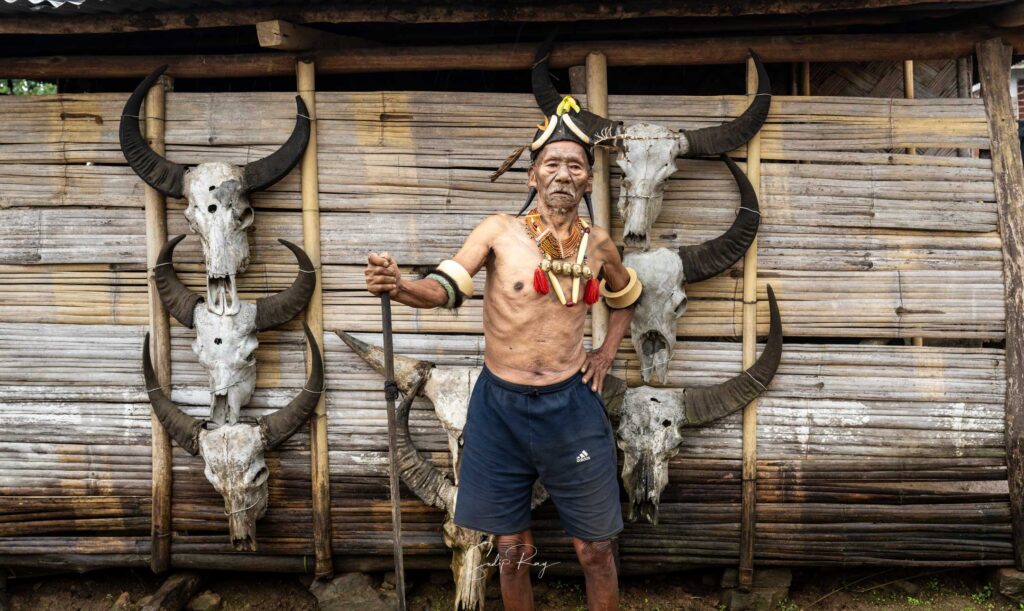
Similarly, the Naga people hold the Hornbill bird in high esteem. Nagaland’s most popular tribal festival has been named after the Hornbill bird. The renowned Hornbill Festival is held every year from 1st to 10th December.
For the Konyak Nagas, Hornbill is associated with love, bravery, and death. The sighting of a Hornbill, hunting it down, and donning its feather is of great importance to this tribe.

FAQ’s-
A. How to reach Mon-
1. In Nagaland, the Konyak tribe is found exclusively in the Mon district.
2. For reaching Mon, you first need to reach Dibrugarh in Assam. Dibrugarh is well-connected with railways and daily flights are also available from Kolkata. From Dibrugarh, Mon is around 115 km away. The distance can be covered in little more than 5 hours since road conditions in Nagaland are quite bad.
3, Though Assam has a good network of public transport, sadly the same cannot be said about Nagaland. Hence, for a hassle-free journey, we suggest hiring a cab from Dibrugarh to reach Mon town. Try booking an SUV vehicle as the roads start getting worse to worst as soon as you enter Mon district.
B. Where to stay-
1. Make Mon your base and then explore the nearby Konyak villages. Mon has better facilities in regard to food and accommodation.
2. For staying, check out Teipha Homestay and Helsa Cottages in Mon town. They provide both food and lodging facilities.
3. During our visit we stayed at Teipha Homestay. The homestay is pretty spacious with enough facilities for car parking. The rooms are quite nice and spacious with basic facilities available including a geyser. However, the food quality left a lot to be desired. Another bonus is that there are four adorable dogs for you to cuddle!
Things to remember:
1. While visiting the Konyak villages, take a local guide with you. This will help you to get to the headhunters with much ease.
2. The Konyak headhunters are now an elderly generation. Most of them are aged above 90, while a few have crossed the age of 100. Hence, they can barely walk or sit properly. Some have weak vision, and most have hearing problems. As such, while documenting or photographing them, please show consideration for their old age. Also, since they are respectable members of the tribal society, we suggest showing the utmost respect to them.
3. The ancient headhunters are quite friendly and they will welcome inside their home with a smiling face. They will show you their ceremonial outfits as well as guns and machetes.
4. In general, we found the Konyak Nagas to be affable and helpful. In every village that we visited, we were welcomed cordially. Also, most of the Konyak Nagas are extremely camera friendly.
5. While visiting the Konyak villages, please show respect for their tribal traditions and culture.
6. For more in-depth information about the Konyaks, read Phejin Konyak’s “The Konyaks: Last of the Tattooed Headhunters”.


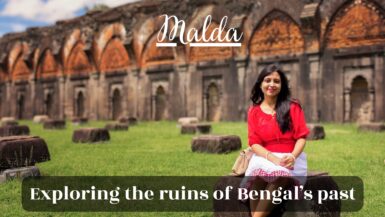

An Excellent Piece of Information.
Thank you so much!
Very informative writings accompanied by a bunch of beautiful pictures. Well done. 👍
Thanks a lot!
This is absolutely top class travelogue Sudip. Couldn’t stop once I started to read it. There is so much history and adventure in these lands. As a child these places were out of bounds due to the Naga insurgency. We used to travel thru Nagaland in huge army convoys. So nice to know about how these cultures have adapted and their transformation.
The photographs are equally compelling.
Hats off to you for this story.
Pardon the typos!
Thank you so much for your encouraging words! Yes, it is really fascinating to explore these areas. We plan to continue bringing forth stories from the Northeast in the future also.
What a beautiful writing! Carry on your good works
Thank you so much!Glad you liked it.